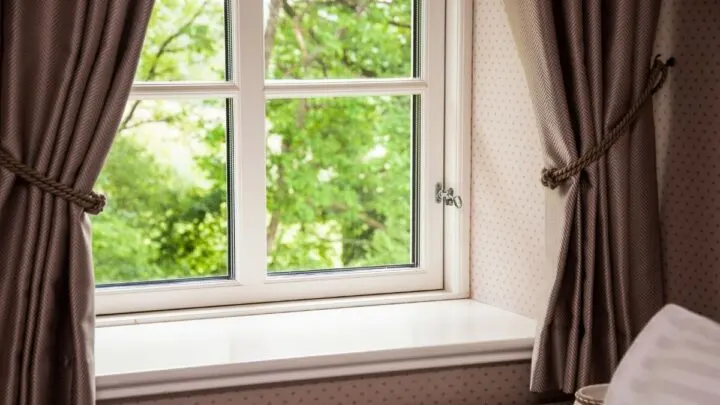Curtains are more than just used for decorative purposes. Drawing the curtains in the daytime can allow the sunlight to enter the house and brighten up your home.
It is probably the first thing you will be doing in the morning to lighten up the house and allow your body to absorb the vitamin D it needs.
As for the aesthetic aspect, curtains gain an enhanced look when elegantly swung to the side by curtain holdbacks or tiebacks.
This is one accessory that is not necessary while hanging a curtain, but turns up the volume in every room. It is a must if you are going for that regal, traditional look and especially goes well with curtains that graze the floor or puddle at the bottom for a dramatic feel.
Curtain holdbacks are generally placed a third of the way up from the floor to allow for an elegant and symmetrical look. However, they can be placed almost anywhere.
But since the main purpose of the holdback is to give a regal look to the curtain, and in all honesty, set the feel for the entire room, it should be placed a third of the way up from the floor.
However, there is more to placing curtain holdbacks and tiebacks than just the measurement from down up.
First, let us understand the difference between a holdback and a tieback to get started:
Holdback And Tieback: What’s The Difference?
A holdback is a piece of hardware made from wood, metal, or iron. It is generally shaped like a “U” and attaches to the wall near the window frame.
A holdback offers great functionality in terms of pulling back the curtain to let the light flow in.
If you want to go for a more traditional look, you might want to invest in tiebacks.
Tiebacks have loops which can be attached to a hook in the wall. Tiebacks are made of flexible and soft materials like cords, ropes, or fabric.
Mainly, a holdback is made of hard material and is best for quickly drawing the curtain, while a tieback is made of flexible material like fabric or rope and is used for decorative or functional purposes.
A Guide To Placing Curtain Holdbacks
If you want to place your curtain holdbacks or tiebacks at the length that offers the best look and functionality, here is a step-by-step approach to guide you how and where to place curtain holdbacks:
Step 1: Measure Your Curtain Length
The first step to installing a holdback or a hook for a tieback is measuring your curtains.
You should start from the point where it hangs loose, which is below the eyelet (specifically for eyelet curtains) or just below the pleat if you have pleated or hook curtains.
After measuring the curtain length, divide by 3.
Step 2: Set The Holdback Height
Once you get the length, mark it on the wall with a pencil. Make sure that you mark the point at least 3 inches from the wall or edge of the window pane.
For example, an 84-inch long curtain will have the holdback point at about 28 inches from the bottom.
For a café or sill-curtain, which are usually used in kitchens, the holdback length will be measured accordingly.
Step 3: Install The Holdback
After marking the perfect position, you need to install the holdback or hook for the tieback on the wall or the window frame.
If you have a tieback or a holdback that does not require installation on the wall like a magnetic holdback or a hook-free tieback, you can wrap the holdback or tieback at the 1/3 length of the curtain.

How To Style Curtain Holdbacks
A general rule of thumb is placing the holdback 1/3 of the length of the curtain from bottom up. However, it can vary depending on how you want your curtain to be styled.
Secure The Top With A Safety Pin
If you want a regal look, you should use a small safety pin to secure the two panels together before drawing them with a holdback or a tieback so the top remains in place.
This is a great tip for eyelet curtains which can easily slide to the side, making it tough to get it to get the flowy look with even gaps when pulled back by a curtain holdback.
Place The Holdback Halfway For Shorter Curtains
For shorter curtains, it is recommended to place the holdback halfway. This is because 1/3 of the total length of a short 36-inch curtain is just 12 inches.
It can easily get off the holdback in case of wind gushing through the windows, thus making it troublesome, especially in busy places like the kitchen.
Place The Holdback Higher For Puddled Drapes
Puddled drapes can surely make for an elegant impression.
However, measuring the curtain all the way to the bottom and then installing the holdback at 1/3 of the length from the bottom can leave a lot of loose fabric at the top, therefore obstructing wind, sunlight, and leading it to look disheveled.
Therefore, for puddled drapes, you need to make the call when installing the holdbacks. You can place it a little higher or just measure 1/3 the length from the floor to the top and install it there.
Make sure you have tested it out so you are not left with drilled holes that are hard to cover and ruin the look of the holdback or the tieback.
Summing Up Curtain Holdbacks
Curtain holdbacks serve a decorative as well as functional purpose.
Installing them or placing them at the right height can make a huge difference to the overall look of the curtain, and therefore, the look and feel of the room.
As a general rule of thumb, holdbacks are installed 1/3 length from the bottom of the curtain. However, this may vary depending on the length and type of curtain.
In the end the point where the holdback is installed depends on your personal liking. Just make sure it is symmetrical on both sides!


